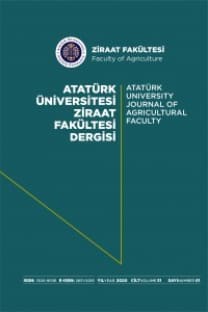ERZURUM ŞARTLARINDA AZOT VE FOSFORLU GÜBRELEME İLE SULAMANIN BAZI KIŞLIK BUĞDAYLARIN TANE VERİMİ, HAM PROTEİN ORANI VE ZELENY SEDİMANTASYON TEST KIYMETİNE ETKİLERİ ÜZERİNDE BİR ARAŞTIRMA
ÖZETEkmeklik buğdayların verimi ile bembel' tanedeki ham proteinoranının ı'e Zeleny Sedimantasyon Test Kıymetlerinin de yüksek ol·ması arzu edilir. Bu çalışmada, azot ve fosforlu gübrelerle sulamanınkış/ık buğdaylarm tane verimine ve tane kalitesine olan etkileri incelenmiştir.Erzurum Ovası topraklarında azot ve fosforlu gübrelerin kışllkbuğdayların verimine etkisi, ön bitkiye göre. değişmektedir. Ön bitkihububat ise dekara tatbik edilen 6 Kg. N ve 7 Kg. Pı05 tane veriminisırasiyle dekara 19.5 ve 19.8 Kg. artı;mıştır. Ön bitki korunga olduğundadekara 6 hatta 12 Kg. N'in ve 7 Kg. Pı05'in tane verimine etkisi olmamıştır.Denemenin yürütüldüğü iki yılda da tatbik edilen sulama suyu taneverimini çok önemli olarak etkilemiştir. Temmuz'un" ilk hl1ftasmdauygulanan 30 mm. sıılama suyu tane verimini dekara 21-26 Kg. artırmıştır;aynı miktar su temmuz'un son haftasında da uygulamnca verimdeki artış dekara 35·45 kg. olmuştur.Her iki yılda da kışlık buğdaylarm tane ham protein oranına yalnıznitrojenin etkisi çok önemli olmuştur; fosfor ve sulama faktörlerininetkisi olmamıştır. Dekara 0, 6 ve 12 Kg. N verilen parsellerden alınanbuğdayların ham protein oranları sırasiyle % 11.25-11.72, 12.78-14.02ve 13.45-15.15 olarak bulunmuştur.Buğdayların ekmeklik kalitesine bir ölçü olabilen Zeleny SedimantasyonTest Kıymeti üzerine nitrojenin müsbet, sulmanın menfi,fosfonm ise bir etkisi bulunmadığı tesbit edilmiştir.Eflect of Nitrogen and Phosphorus Fertilizers andirrigation on the yield, Protein Content and Zeleny Sedimantation Valufe of winter wheats Under the Ecological Conditiom of ErzurumIn this research the effect ofnitrogen and phosphorus fertilizers and irrigation on the yield, protein contentand Zeleny Sedimantation values ofwinter wheats were exainİned. Theexperiments were conducted in 1971and 1972 at number 6 and 4 well of theExperiment Station of Atatürk Universitywhich can represent the soils ofmost part of Erzurum vaHey, Bozostaya,Warrior, Lancer, Yayla-305 andOdin winter wheat varieties were usedın the experiments.Bezostaya, Warrior and Lancerproduced more grain yield than Yayla.305 and Odin. As two-year averages,the yields of varieties were 310, 296,283, 217, and 216 kg/da. respectively..In 1971, no significant differencewas found between the effects of 6and 12 kg. nitrogen levels; but 6 kg.N/da. level increased the yield by 19.5kg/da.., as compared to unfertilizedplots. In 1972, nitrogen did not affectthe grain yield. Phosphorus affectedthe grain yield in the same way as didnitrogen in the first year, by inereasingthe grain yield 19.8 kg/da. as comparedwith no-fertilizer treatment, at7 kg. n05/da. leveL. In the in yie1d;but the inerease in yield was only 21kg/da. it has been found that the expencesof fertilizer applied did notcompensate the inerease in the grainyield.In both years, watering treatmantaffeeted the garin yield significantly.One irrigation during the g1Owingperiod increased the grain yieldby 21.3 and 25.7 kg/da., two irrigationtreatments incerased the garin yieldby 35.,9 and 45.4 kg/da., in 1971 and1972, respectively.The average curede protein contentsof the wheat· varieties used in the experimenswere 12.50-13.52 %, and thevarietal differences were not significantat 5 % levetIn both years, the only faetoreffective on the crude protein contentsof the winter wheat varieties was nitrogen.The other factors, phosphorusand water treatments shöwed 'no significanteffeets on this character. Thecrude protein content inreased with:inereasing rates of nitrogen application.The crude protein eontents ofthe wheats harvested from the plotsto which 0,6 and 12 kg.N/da. appliedwere 11.25-11.72; 12.78 - 14.02; and13.45-15.15 % respectively.Varietal differences in Zeleny'ssedimentation test values were signifieantlydiffer.ent in both years ofexperimentation. In 1971 the averageZeleny's sedimantation test values overwater and fertiIizier treatment-s of thevarieties Warrior, Bezostaya, Lancer,Yayla-305, and Odin were 57.28, 45.4~29,87, and 26.43 ml. respeetively. Bezostayaand Laneel', Yayla-305 andOdin weıe not signifieantly differentin th.is respect; but there was a significantdifference between the averagetest values of these groups. On theother hand, Warrior's sedim.antation"test values si.gnificant1y Çifferent fromthe other varieties. In 1972 thesedimantationtest values of Bezostaya, Warriorand Laneel' vari.eties were 67. 31, 67.03, and 56.26 ını., respective1y. Thedifferences between these values werenot siginifieant. There was not a signifieantdifference between Yayla-305(33.42 ını.) and Odin (25.25 ını.) inthis respect; but the difference betweenthe averages of these two groups washighly significant. it means the sedimentationtest values of Warrior and Bezostaya were at the highest and thatof Yay1a-305 and üdin were at thelowest level, in both years. The Laneervariety took an average position, withits sedimantition test values of 49.50ml., as the two-year average.According to the i 97 i and 1972results, nitrogen had a highly significantlinear effect on sedimentation testvalues, whi1e phosphorus had no significanteffec!. The sedimantation test 'values increased with increasing levelsof nitrogen fertilization. In 1971, and1972; 0,6 and 12 kg.N/da. levels ofnitrogen ,gaye rise to the sedimentationvalues of 27.90, 43.97, 49.25 ml. and41.07, 52.41, 56.09 ml. respectively. Inthe first year, all of the differences amongthese avereges were high1y significant;in the second year, the differeneebetween 6 and 12 kg.N/da.levels was not significant, but the differencebetween unfertilized and thesetwo leve1s.In both years, the Ze.leny sedimentationtest values of all varietiesthe average of fertilizer treatment decreasedas the level of water treatmentincreased. The sedimentation test valuesof the wheats harvested from the plotswhich had O, 30 and 60 mm. levels ofirrigation were 41.34,40.05 and 39.74ml. in 1971; 50.77, 50.33 and 48.46ml. in 1972 respectively. The differencesbetween sediment<j.tion va1ues of Oand 60 mm. irrigation were significant,whi1e that of Oand 30 mm. was not inbotb years.According to two-year results ofthese experiments, it may be conc1udedthat; under the eco10gica1 conditions ofErzurum; Bezostaya, Warrior Lancervarieties should be grown. if a 1egumplant is not a previous crop, a totalamount of 18-19 kg/da. ammoniumnitrate (% 32 N) should be apppliedby dividing to 3 parts, during the growingperiod; and if water is avalable,winter wheats should be irrigated, atleast two times in a year, in the firstand last weeks of july.
Anahtar Kelimeler:
-
- ISSN: 1300-9036
- Yayın Aralığı: Yılda 3 Sayı
- Yayıncı: AVES Yayıncılık
Sayıdaki Diğer Makaleler
TOPRAK TASNİFİNİN TARİHÇESİ, GAYELERİ ve KULLANILDIĞI SAHALAR
TÜTÜNCÜLÜĞÜMÜZÜN DURUMU VE GELECEĞİ
MİNİMUM TOPRAK İŞLEME METODU ve BUNUN TOPRAK ve SU MUHAFAZASI BAKIMINDAN ÖNEMİ
TOPRAK STRÜKTÜRÜNE İLİŞKİN OLARAK BİTKİ MÜNAVEBESİ
DİSKRİMİNANT ANALİZİ VE BUNUNLA İLGİLİ BAZI PROBLEMLER ÜZERİNDE BİR ARAŞTIRMA
FARKLI SÜRÜM DERİNLİKLERİNİN TOPRAKLARIN İNFİLTRASYON HIZLARINA ETKİSİ ÜZERİNDE BİR ARAŞTIRMA
Hurşit ERTUĞRUL, Feridun Hakgören
TARIM KESİMİNDEKİ GiZLİ İŞSİZLİK VE EKONOMİK GELİŞME YÖNÜNDEN ÖNEMİ
